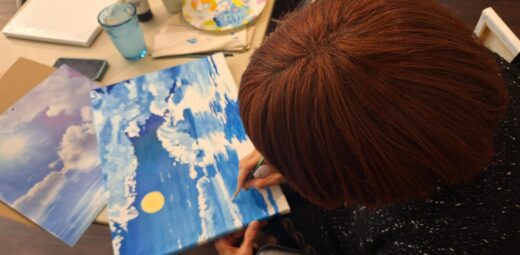
May 13Painting Away the Blues: Art Therapy’s Role in Mental Health Healing
If you were given a blank canvas and a drawer full of colored pencils and paints, what would you make? Would you use all the colors? Or stick to just a few?
For senior residents at Linbrook Court in Anaheim, California, art has become a way for them to express their thoughts and feelings. It is a therapeutic outlet. The diverse senior community is home to a large Korean population, who account for nearly half of the residents who call Linbrook Court home.
Storytelling Through Art
According to Mental Health America, more than two million older adults suffer from depression. And only 42% are willing to seek help from a healthcare professional.

Despite speaking different languages, Linbrook Court Resident Services Coordinator Jocelyn Grigsby has worked hard to forge a positive relationship with the residents and get them involved in onsite programming.
“If you don’t speak their language, they’re hesitant to join in activities,” Jocelyn explained. Some of the residents have stepped in to help her with translation.
Mercy Housing communities in Southern California have been working with the Southern California Council on Aging for the past seven years to bring programs to residents. When looking at ways she could connect with residents, Jocelyn contacted the organization about bringing additional programs to Linbrook Court.
“They said ‘yes,’ and suggested an art therapy program,” Jocelyn said. “My Colors. My Mind” is an innovative, multicultural art therapy class where participants are encouraged to celebrate the colors of their lives. The goal is to decrease isolation, and feelings of depression, while creating community, and reducing the stigma around mental health.
The class has grown from an initial three or four participants to 15 today and is one of the most popular activities in the community.
The Benefits of Art Therapy
Older patients with symptoms of depression have roughly 50% higher healthcare costs than non-depressed seniors.
“It’s an amazing experience how people from different parts of the world can communicate through their artwork,” Jocelyn added. “It is good for brain stimulation, and it’s been a good tool for people to heal because they can inspire themselves. It is also focused on interaction for more isolated residents.”
Jocelyn has been a fan of art for years. “I believe that art can switch a negative into a positive,” she explained. “Take gray and dark colors and turn them into bright, pastel colors.”
Participants are encouraged to paint whatever they want. “Some residents paint what they want to draw, and others bring calendars to copy and color.”

The art instructor from the Council on Aging is Korean and the residents feel comfortable with her. “We have an 88-year-old Vietnamese resident who attends the art class,” Jocelyn shared. “She can’t speak English but communicates with the instructor, which is wonderful.”
A Community Connects
Jocelyn has already added a jewelry-making class for residents, “We have a volunteer senior here who teaches the jewelry class which is another way for residents to express their creativity,” she said.
And soon, she will be offering a new journaling program. “I started with a gratitude journal,” Jocelyn explained, “What am I thankful for this day? Or to express my feelings.”

In the meantime, Jocelyn has started to display the resident’s art throughout Linbrook Court. “They donated a lot of paintings to me. I have them up in our community room, the computer lab, and my office.”
For Linbrook Court residents, tapping into their creativity enables them to celebrate their cultures and individuals, form meaningful connections, and experience happiness together.
You may also like:
- At 87, Ms. Sandra is Living Her Best Life Sisters Villa resident, Ms. Sandra’s social calendar fills up pretty quickly these days. Whether she...
- Young Minds Become Entrepreneurs Through YouthBiz Program Bringing financial education to Mercy Housing communities isn’t just for adults. Recently, Mercy Housing Mountain...
- How Kids Kept Busy During Summer Vacation – One Hint: Adventures Kids need support to succeed in school and in life, which is why Mercy Housing...
- New Residents Celebrate Permanent Homes and Supportive Services at 6th Street Place Dedication Built using modular construction technology, the new Skid Row-area permanent supportive housing community provides 93...
Stay Up To Date
Get news on Mercy Housing and inspiring stories of change delivered to your inbox.


